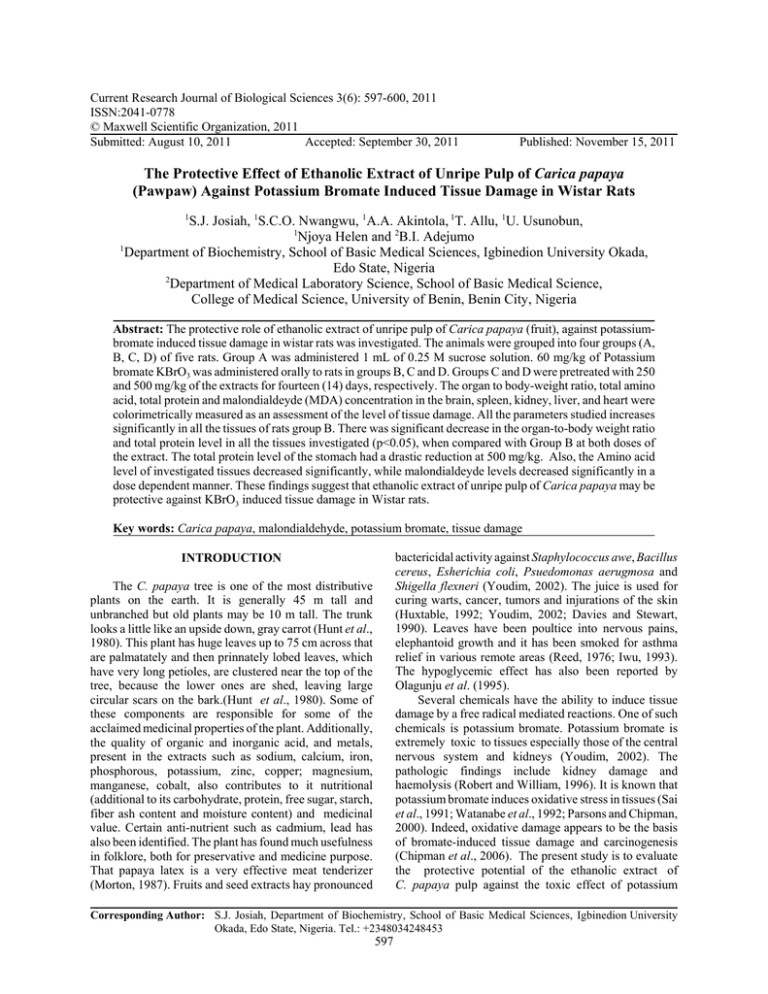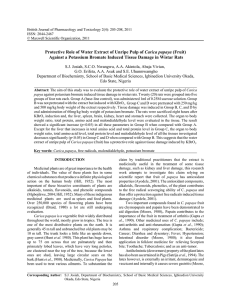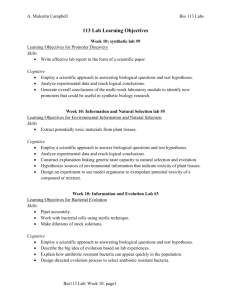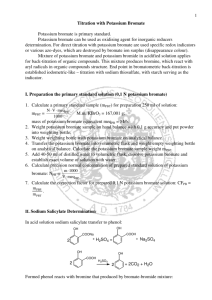Current Research Journal of Biological Sciences 3(6): 597-600, 2011 ISSN:2041-0778
advertisement

Current Research Journal of Biological Sciences 3(6): 597-600, 2011 ISSN:2041-0778 © Maxwell Scientific Organization, 2011 Submitted: August 10, 2011 Accepted: September 30, 2011 Published: November 15, 2011 The Protective Effect of Ethanolic Extract of Unripe Pulp of Carica papaya (Pawpaw) Against Potassium Bromate Induced Tissue Damage in Wistar Rats 1 S.J. Josiah, 1S.C.O. Nwangwu, 1A.A. Akintola, 1T. Allu, 1U. Usunobun, 1 Njoya Helen and 2B.I. Adejumo 1 Department of Biochemistry, School of Basic Medical Sciences, Igbinedion University Okada, Edo State, Nigeria 2 Department of Medical Laboratory Science, School of Basic Medical Science, College of Medical Science, University of Benin, Benin City, Nigeria Abstract: The protective role of ethanolic extract of unripe pulp of Carica papaya (fruit), against potassiumbromate induced tissue damage in wistar rats was investigated. The animals were grouped into four groups (A, B, C, D) of five rats. Group A was administered 1 mL of 0.25 M sucrose solution. 60 mg/kg of Potassium bromate KBrO3 was administered orally to rats in groups B, C and D. Groups C and D were pretreated with 250 and 500 mg/kg of the extracts for fourteen (14) days, respectively. The organ to body-weight ratio, total amino acid, total protein and malondialdeyde (MDA) concentration in the brain, spleen, kidney, liver, and heart were colorimetrically measured as an assessment of the level of tissue damage. All the parameters studied increases significantly in all the tissues of rats group B. There was significant decrease in the organ-to-body weight ratio and total protein level in all the tissues investigated (p<0.05), when compared with Group B at both doses of the extract. The total protein level of the stomach had a drastic reduction at 500 mg/kg. Also, the Amino acid level of investigated tissues decreased significantly, while malondialdeyde levels decreased significantly in a dose dependent manner. These findings suggest that ethanolic extract of unripe pulp of Carica papaya may be protective against KBrO3 induced tissue damage in Wistar rats. Key words: Carica papaya, malondialdehyde, potassium bromate, tissue damage bactericidal activity against Staphylococcus awe, Bacillus cereus, Esherichia coli, Psuedomonas aerugmosa and Shigella flexneri (Youdim, 2002). The juice is used for curing warts, cancer, tumors and injurations of the skin (Huxtable, 1992; Youdim, 2002; Davies and Stewart, 1990). Leaves have been poultice into nervous pains, elephantoid growth and it has been smoked for asthma relief in various remote areas (Reed, 1976; Iwu, 1993). The hypoglycemic effect has also been reported by Olagunju et al. (1995). Several chemicals have the ability to induce tissue damage by a free radical mediated reactions. One of such chemicals is potassium bromate. Potassium bromate is extremely toxic to tissues especially those of the central nervous system and kidneys (Youdim, 2002). The pathologic findings include kidney damage and haemolysis (Robert and William, 1996). It is known that potassium bromate induces oxidative stress in tissues (Sai et al., 1991; Watanabe et al., 1992; Parsons and Chipman, 2000). Indeed, oxidative damage appears to be the basis of bromate-induced tissue damage and carcinogenesis (Chipman et al., 2006). The present study is to evaluate the protective potential of the ethanolic extract of C. papaya pulp against the toxic effect of potassium INTRODUCTION The C. papaya tree is one of the most distributive plants on the earth. It is generally 45 m tall and unbranched but old plants may be 10 m tall. The trunk looks a little like an upside down, gray carrot (Hunt et al., 1980). This plant has huge leaves up to 75 cm across that are palmatately and then prinnately lobed leaves, which have very long petioles, are clustered near the top of the tree, because the lower ones are shed, leaving large circular scars on the bark.(Hunt et al., 1980). Some of these components are responsible for some of the acclaimed medicinal properties of the plant. Additionally, the quality of organic and inorganic acid, and metals, present in the extracts such as sodium, calcium, iron, phosphorous, potassium, zinc, copper; magnesium, manganese, cobalt, also contributes to it nutritional (additional to its carbohydrate, protein, free sugar, starch, fiber ash content and moisture content) and medicinal value. Certain anti-nutrient such as cadmium, lead has also been identified. The plant has found much usefulness in folklore, both for preservative and medicine purpose. That papaya latex is a very effective meat tenderizer (Morton, 1987). Fruits and seed extracts hay pronounced Corresponding Author: S.J. Josiah, Department of Biochemistry, School of Basic Medical Sciences, Igbinedion University Okada, Edo State, Nigeria. Tel.: +2348034248453 597 Curr. Res. J. Biol. Sci. 3(6): 597-600, 2011 bromate on tissues, using the extent of lipid peroxidation, total protein and total amino acid level as well as the organ-body weight ratio as an indication of the effect of the toxicant and the extract on the tissues investigated. Estimation of malondialdehyde level in tissues was measured by the method of Ohokawa et al. (1979). MATERIALS AND METHODS Table 1 shows the effect of the toxicant and the extract on organ to body weight ratio of all tissues investigated as an assessment of inflammation and necrosis in all the groups. Rats in group B showed a significantly high organ-body weight ratio, indicating that potassium bromate is capable of causing inflammation of tissues as reported by Kurokawa et al. (1990). The kidney, Liver and the heart showed the highest level of protection as shown by significant decrease (p<0.05) at both 250 and 500 mg/kg body weight treated extract when compared with the base - line control and group B. The brain was only protected at 500 mg/kg body weight of extract. This may be partially due to selective permeability of the antioxidant composition of the extract by the blood - brain barrier (Takeshi et al., 1996). The spleen showed inflammation at 250mg/kg body weight of but at 500 mg/kg body weight, it was protected against the cytotoxic action of potassium bromate. The antiinflammatory activity of this plant has been traced partially to its linoleic acid composition (Feretti and Flanagan, 1996) an agent that is strongly soluble in polar solvent like ethanol. This explains the reason for the dose dependent protection of some of the organs. Ascorbate composition can also account for the cytoprotection against potassium bromated induced free radicals generation (Duke, 1992b). In the stomach at 250 mg/kg body weight, the ratio is higher when compared to the base - line control, this is possibly due to accumulation of the toxicant and poor detoxification of xenobiotic agents by the stomach (Robert, 2001), an effect which is overcome by increased concentration of the extracts. The amino acid level was estimated (Table 2) in all tissues studied. The amino acids level was significantly higher in all the tissues investigated (p<0.05) except the heart at 250 mg/kg body weight when compared with the base line group. This may be due to excessive proteolytic process as induced by the toxicant and the utilization of energy derivable from amino acid oxidation to drive the biochemical process of detoxification of free radical induced by the action of the toxicant. Another possible RESULTS AND DISCUSSION Plant sample collection and identification: Fresh, unripe mature fruits of Carica papaya were harvested from a tree in Igbinedion University campus premises. The fruits were identified and authenticated at the Department of Botany, Igbinedion University Okada, Edo state, Nigeria. Experimental animals: Twenty wistar rats were purchased from the animal house at the University of Ibadan, Oyo State. The rats were housed in wellventilated cages in the animal house of Igbinedion University. They were acclimatized for two weeks and fed with rat cubes. Experimental design: Group A: Base-line control (given 1 mL 0.25 M sucrose solution) Group B: Second control (oral administration of 60 mg/kg body weight of KBrO3 but not pretreated with the plant extract) Group C: Test group, Pretreated with extract (250 mg/kg) for 14days, then oral administration of KBrO3 (60 mg/kg) Group D: Test group, Pre-treated with extract (500 mg/kg) for 14days, then oral administration of KBrO3 (60 mg/kg). Extraction of juice from fresh samples: Fresh unripe fruits of Carica papaya were peeled, seeds removed and the pulp cut into small pieces. 500 g of the small pieces were weighed and blended. 1.5 L of ethanol was then used for extraction. The extract was filtered using a whatman filter paper 125 mm and concentrated using a rotary evaporator. Biochemical analysis: Total tissue protein was estimated by follin-ciocalteau lowry method (Lowry et al., 1951), while amino acid assay was carried out using the ninhydrin method of Magne and Larher (1992). Table 1: Effect of Potasium Bromate and ethanolic extract of Carica papaya pulp on organ-to-body weight ratio of the tissues Tissues Group A Group B Group C 250 mg/Kg Group D 500 mg/Kg Kidney 0.07±0.001 0.12a ±0.040 0.08b,c±0.0180 0.07b,c±0.021 a a Stomach 0.01±0.003 0.96 ±0.080 0.21 ±0.0220 0.19b,c ±0.013 0.05b,c± 0.036 0. 04b,c±0.012 Heart 0.05±0.020 0.13 a ±0.000 0.64a,d±0.1350 0.06b ±0.011 Spleen 0.06±0.006 0.14a ±0.0120 a a Brain 0.91±0.010 0.27 ±0.011 0.24 ±0.0220 0.13b,c ±0.018 0.47b,c±0,0160 0.41b,c ±0.113 Liver 0.42±0.004 0.85 a±0.600 Values (mean±SEM) for 5 determinations; a: Significantly higher (p<0.05) when compared with group A; b: No significant difference (p<0.05) on comparison with group B; c: Significantly lower (p<0.05) on comparison with group B; d: Significantly higher (p<0.05) on comparison with group B; e: Significantly lower (p<0.05) on comparison with group B 598 Curr. Res. J. Biol. Sci. 3(6): 597-600, 2011 Table 2: Effect of Potasium Bromate and ethanolic extract of Carica papaya pulp on total amino acid (mg/g) of the tissues Tissue Group A Group B Group C 250 mg/Kg Group D 500 mg/kg Kidney 84.13±8.244 106.92a±10.010 106.76a±10.113 92.99b,c±5.198 a a Stomach 39.22±5.667 76.24 ±7.270 73.91 ±8.139 26.15b,c±8.125 92.60e,c±1.928 36.69e,c±8.181 Heart 193.10±12.220 204.18a±15.200 95.39e,c±8.397 26.46c,c±7.821 Spleen 46.24±8.323 160.01a±9.360 135.51a±10.263 105.18b,c±11.152 Brain 101.57±15.270 167.20a±8.224 52.28a±3.388 8.34b,c±3.388 Liver 19.43±2.620 84.22a±7.342 Values (mean±SEM for 5 determinations; a: Significantly higher (p<0.05) when compared with group A; b: No significant difference (p<005) on comparison with group B; c: Significantly lower (p<0.05) on comparison with group B; d: Significantly higher (p<0.05) on comparison with group B; e: Significantly lower (p<0.05) on comparison with group B Table 3: Effect of Potasium Bromate and ethanolic extract of Carica papaya pulp on total protein (mg/g) level of the tissues Tissue Group A Group B Group C 250 mg/Kg Group D 500 mg/kg 207.57a±11.716 191.29b±18.173 Kidney 178.20±10.230 516.42a±17.230 479.16a,c±14.471 23.23a,c±5.138 Stomach 20.74±4.280 496.18a±26.455 278.33a,c±18.181 146.67b,c±12.197 Heart 150.12±12.342 402.34a±14.260 425.87a,c±23.251 52.03b,c±5 .072 Spleen 38.44±3.333 469.21a±29.330 235.39a,c±28.811 201.88b,c±12.703 Brain 205.17±16.227 311.75a±9.001 Liver 267.67±22.667 541.18a±25.228 456.73a,c±27.182 269.67b,c±18.671 Values (mean±SEM) for 5 determinations; a: Significantly higher (p<0.05) when compared with group A; b: no significant difference (p<0.05) on comparison with group B; c: Significantly lower (p<0.05) on comparison with group B; d: Significantly higher (p<0.05) on comparison with group B; e: Significantly lower (p<0.05) on comparison with group B Table 4: Effect of Potasium Bromate and ethanolic extract of Carica papaya pulp on malondialdehyde levels (mg/g) of the tissues Tissue Group A Group B Group C 250 mg/Kg Group D 500 mg/kg 18.70a,c±1.785 10.28a,c±2.175 Kidney 0.78±0.000 24.67a±2.333 Stomach 4.24±1.220 21.36a±1.112 10.89a±2.117 5.18b±1.181 3.60b±0.143 11.97a±5.132 Heart 2.96±0.567 19.77a±3.667 a a,c 1.98 ±0.128 1.96c±0.175 Spleen 4.06±0.040 4.90 ±0.730 1.98a,c±0.128 0.81b,c±1.318 Brain 1.02±0.128 14.11a±3.270 4.76a,c±1.113 6.58a,c±1.217 Liver 0.27±0.000 16.30a±5.002 Values (mean±SEM) for 5 determinations; a: Significantly higher (p<0.05) when compared with group A; b: No significant difference (p<0.05) on comparison with group B; c: Significantly lower (p<0.05) on comparison with group B; d: Significantly higher (p<0.05) on comparison with group B; e: Significantly lower (p<0.05) on comparison with group B explanation is the accumulation of amino acids derived from the plant extracts which was previously been reported to be rich in alanine (Duke, 1992a), arginine (Huxtable, 1992), methionine (Davies and stewart, 1990), glycine, aspartate and tryptophan (Duke, 1992b). The second possibility of plant derived amino acids and its accumulation is discarded on the basis that stomach should have been the primary organ where amino acids should accumulate as shown in 250 mg/kg body weight. However at 500 mg/kg body weight, the amino acid is not comparable with the base line control. This shows that amino acids in the tissues were derived from proteolytic cleavage of the cellular proteins and the cells were protected at higher dosage of the extract. Similar results were obtained for the spleen. The protective function of protein is dual; they protect the cells by maintaining the cellular integrity (cytoskeletal proteins), while some protect the cells against chemical injuries, free radical species, xenobiotic agents metabolizing proteins (Porter and Coom, 1991). An increase in protein synthesis during chemical injury is protective, especially with the induction of the synthesis of detoxifying protein (Rush More and Pickeh, 1983). Table 3 showed the total protein level of tissues investigated, at 250 mg/kg body weight the protein composition of all tissues were significantly higher (p<0.05) than the base line control, this may be due to induction of the free radical enzymes, a property that has been reported for flavonoid (Youdim et al., 2002). Flavonoid have been isolated and extensively characterized in C. papaya (Duke, 1992a). At 500 mg/kg body weight, there were no significant differences between the protein level of most tissues studied and the base line group (p<0.05). This may be due to the detoxification of free radicals generated by the potassium bromate without inducing the formation of enzymes. The ability of C. papaya to scavenge free radicals is traced to the gamma alanine, alpha linolenic acid, lycopene, methyl salicylate component of C. papaya which accumulates with increasing concentration of the extract (Iwu, 1993; Josiah et al., 2010). Lycopene, linolenic acid and flavonoids have been reported to be the inhibitors of lipid peroxidation, which reduces the formation of malondialdehyde, the major product of lipid peroxidation. Table 4 showed the malondialdehyde levels. At 250 mg/kg body weight, the MDA level is significantly higher (p<0.05) in all organs studied when compared with the base line group with the exception of the heart, but significantly lower when compared with those groups induced with potassium bromate only. This shows 599 Curr. Res. J. Biol. Sci. 3(6): 597-600, 2011 protection by the extract. The same results were obtained for 500 mg/kg body weight treated kidney and liver but the spleen and the brain were well protected at 500 mg/kg body weight of the extract. Magne, C. and E. Larher, 1992. Higher sugar content of extract interfere with colorimetric determination of amino acid and free praline. Ana. Biochem., 200(1): 115-118. Morton, J.F., 1987. Major Medicinal Plants. C.C. Thomas Spring Field, IL. Ohokawa, H., N. Oshishi and K. Yagi, 1979. Assay for lipid peroxidation in animal tissues by thiobarbituratic acid reaction. Ana. Biochem., 75: 351-358. Olagunju, J., A. Ogunlana and Z. Gile, 1995. Preliminary studies on the hypoglycemic activity of ethanolic extract of unripe mature fruits of pawpaw. Nig. J. Biochem. Mol. Biol., 10:21-23. Parsons, J.L. and J.K. Chipman, 2000. The role of glutathione in DNA damage by potassium bromate in vitro. Mutagenesis, 15(4): 311-316. Porter, T.D. and M.J. Coom, 1991. Cytochrome P450: Multiplicity of Isoform, substrate and catalytic regulatory mechanism. J. Bol. Chem., pp: 226-1346. Reed, C.F., 1976. Information Summaries on 1000 Economic Plants, Type Script Submitted to the USDA. Robert, I.K., 2001. Handbook of Pesticide Toxicology. 1st Edn., Academic Press, pp: 20. Robert, I.A. and B.C. William, 1996. Carcinogenicity of potassium bromate in rabbit. Biol. Educ., 34: 114-120. Rush More, T.H. and C.B. Pickeh, 1983. Glutathione 3transferase, structure regulation and therapeutic application. J. Bol. Chem., 268: 11475-11478. Sai, K., A. Takagi and T. Umemura, 1991. Relation of 8hydrogen guanosine formation in rat kidney to lipid peroxidation, glutathione level and relative organ weight after a single dose administration of potassium bromate. Jpn. J. Cancer Res., 82(2): 165-169. Takeshi, M., I. Masayo, O. Jiro, K. Hideko and O. Yuko, 1996. Free radical scavengers suppress the accumulation of platinum in the cerebral cortex. Biomed. Life Sci., 55(2): 1-7. Watanabe, T., T. Abe and M. Satoh, 1992. Two children with bromate intoxication due to ingestion of the second preparation for permanent hair waving. Act. Paediatr. Jpn., 34(6): 601-605. Youdim, K., J. McDonald, W. Kalt and J. Joseph, 2002. Potential role of dietary flavonoids in reducing micro-vascular endothelium volubility to oxidative and inflammatory Results J. Nut, Biochem., 13(5): 282-288. CONCLUSION In conclusion, potassium bromate has been proven to be cytotoxic, causing tissue damage, and the ethanolic extract of Carica papaya can offer protection against damage that may be caused by this chemical. However the protection offered by Carica papaya was seen to be effective at higher concentrations of the extract. REFERENCES Chipman, J.K., J.L. Parsons, E.J. Beddowes, 2006. The multiple influences of glutathione on bromate genotoxicity: Implications of dose-response relationship. Toxicol., 221: 187-189. Davies, S. and A. Stewart, 1990. Nutritional Medicine. Avon Books, New York. pp: 509. Duke, J.A., 1992a. Handbook of Phytochemistry Constituents of Herbs and Other Economic Plants, F.I. CRC Press, Boca Raton. Duke, J.A., 1992b. Handbook of Biologically Active. F.I. CRC Press, Boca Raton. Feretti, A., V.P. Flanagan, 1996. Anti thromboxane Activity of Dietary Alpha Linolenic Acid: A Pilot Study, Prostaglandins Leuko Trienes Essential Fatty Acids, ARS, USDA, 54(6): 451-455. Hunt, S., J.L. Goff and J. Handbook, 1980. Nutrition Principles and Chemical Practices John Wiley and Sons, New York, pp: 4-52, 439-462. Huxtable, R.J., 1992. The myth of beneficent nature the risk of herbal preparations. Ann. Inter. Med., 177(2): 165-166. Iwu, M.M., 1993. Handbook of African Medicinal Plants. PPO. 1 CRC press, Inc Florida. Josiah, S.J., O. Omotuyi, K.A. Oluyemi, U.I. Ezea, E.S. Uhunmwangho, S.C. Nwangwu, O.A. Oyesola and H. Njoya, 2010. Protective role of aqueous extract of Hibiscus sabdariffa (calyx) against potassium bromate induced tissue damage in wistar rats. African J. Biotech., 9(21): 3218-3222. Kurokawa, Y., A. Mawkawa, M. Takabasi and Y. Hayashi, 1990. Toxicity and Carcinogenity of Potassium bromated-A renal Carcinogen. Envirn. Health Prospect, 87: 309-335. International Agency for Research on Cancer. Lowry, O.H., N.J. Rosebrough, A.L. Farr and R.J. Randall, 1951. Protein measurement with the follin-phenol reagents. J. Biol. Chem., 193: 265-275. 600






